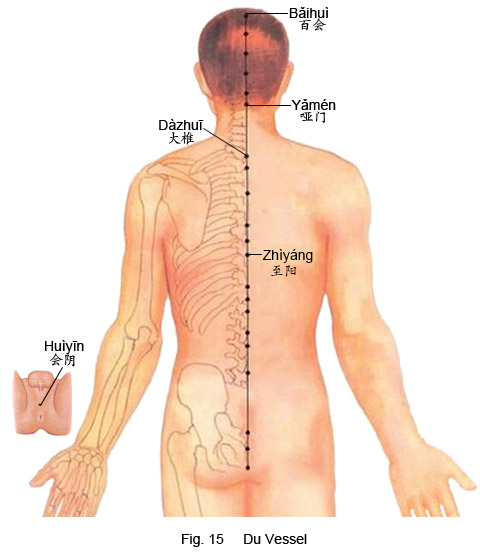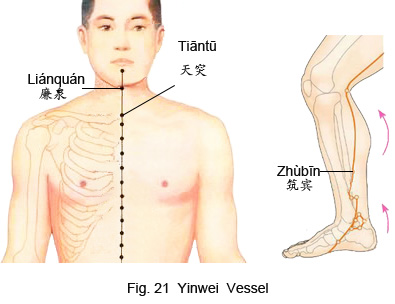The Concepts and Characteristics of Eight Extraordinary Channel (Vessels)
The eight extraordinary (extra meaning different) channels (vessels) are the eight channels that are not distributed as regularly as the twelve regular channels. They include the Du, Ren, Chong, Dai, Yinqiao, Yangqiao, Yinwei and Yangwei channels. Since the extraordinary channels ( vessels ) have different running routes and have no direct connections with the viscera, they are therefore called the “extraordinary channels (vessels) “.
Characteristics of these channels are as follows: they are not distributed as regularly as the twelve regular channels and they have no direct connection or affiliation to the viscera. However, while the extraordinary fu – viscera have certain connections with some of the zang – fu – viscera, there are no exterior – interior relations among the eight extraordinary vessel.
The Physiological Functions of Eight Extraordinary Channels (Vessels)
The eight extraordinary channels (vessels) run vertically, transversely, and crosswise among the twelve channels. The function of the eight extraordinary channels (vessels) mainly present with the following three aspects:
1. Further strengthening the communication of twelve regular channels
In the running and distributing process, the eight extraordinary channels (vessels) crisscross with some of the twelve channels so as to strengthen the communication among the twelve channels. For example, the Du Vessel “governs all the yang channels “ and meets with the six yang channels of both hand and foot at Dahui point (GV 14).
2. Regulating the qi and blood of the twelve channels
The eight extraordinary channels (vessels ) are intricately distributed. At the same time, they circulate among the twelve channels. When the qi and blood of the twelve channels becomes over abundant, it will flow into the eight extraordinary channels (vessels) for storage. When the qi and blood of the twelve channels becomes deficient, the extraordinary channels ( vessels ) will supply stored qi and blood so as to compensate, irrigate, and supply the tissues of the whole body.
3. Participating the adjustment of reproduction function and braid and marrow
Contributing to reproductive health, and the functions of the brain and marrow. The eight extraordinary channels (vessels) are closely related to the liver, kidney and urinary bladder. They play a role in the functions of menstruation, leucorrhea, fetation, and the labor of women. Thus, they participate in the reproductive function of the human body. In their running and distributing processes, they rather closely communicate with brain and marrow. The channels communicate with them both physiologically and pathologically.
The Running Routes and Functional Characteristics of Eight Extraordinary Channels (Vessels)
1. Du Vessel
1.1 Running Route
The Du Vessel originates from the interior of the womb. Descending, it emerges at the perineum. It then ascends along the inside of the spinal column to Fengfu (GV 16) at the nape. From there, it enters the cranial cavity to communicate with the brain. It further runs following the midsagittal line on the head, via the vertex, forehead, nose and upper lip, and reaches the frenulum of the upper lip (Yinjiao, GV 28). It also has branches joining the kidney and passing through the heart (Fig. 15).
1.2 Functional characteristics
Du here means governing or commanding. Therefore the functional characteristics of Du Vessel are as follows :
1.2.1 Adjusting the qi and blood of the yang channels
The Du Vessel runs along the mid – line of the back. The Du Vessel‘s qi meets the qi of the three yang channels of the hand and foot, as well as the Yangwei Vessel on numerous occasions. Due to this, it has adjusting function on the yang channels of the whole body. This is why it is also called “the sea of yang channels “.
1.2.2 Having close relations with the brain, spine and kidney
The Du Vessel runs along the inside of the spine, branches out to join the kidney, and continues upwards to the brain. The Kidney governs the storing of essence and the generating of marrow, and the brain is the sea of marrow.Due to these connections, the Du Vessel has a close relationship with the brain, marrow and the kidney.
2. Ren Vessel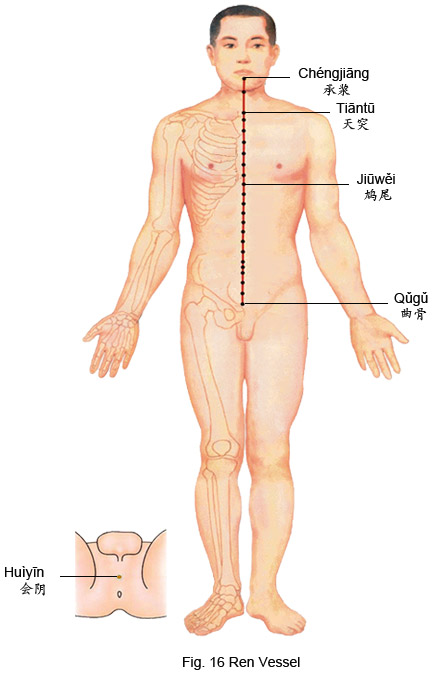
2.1. Running route
The Ren Vessel originates from the interior of the womb. Descending, it emerges at the perineum. It then ascends via the mons pubis along the mid – line of the abdomen and chest to the throat. It further runs up to the mandibular region, curves round the lips, and passes through the cheek. At this point it bifurcates to arrive at the infraorbital regions (Fig. 16 )
2.2 Functional characteristics
Ren here means assuming, or undertaking. The functional characteristics of Ren Vessel are as follows:
2.2.1 Controlling the qi and blood of yin channels
The Ren Vessel runs along the anterior midline of abdomen. Its vessel qi communicates with the three yin channels of the foot and Yangwei Vessel. The channel links with the yin channels, so it has an adjusting function on the qi and blood of yin channels. Therefore, it is called “the sea of yin channels “.
2.2.2 Dominating the uterus and pregnancy
Since the Ren Vessel originates in the uterus, it is able to adjust the menses and promote the reproductive function of women. It shares a relationship with pregnacy, so it is said that “the Ren Vessel dominates the uterus and pregnancy”, and is the root of giving birth.
3. Chong Vessel
3.1 Running route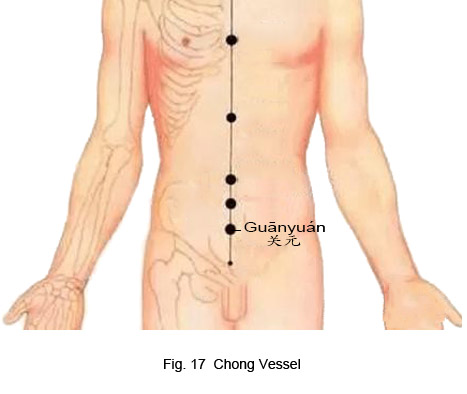
The Chong Vessel originates in the womb. Descending, it emerges at the perineum, then superficially bifurcates into three branches. One runs posterior and connects with the Du vessel, running in front of the spinal column. Another reaches the inguinal region (Qijie, ST 30), joins the kidney vessel of foot Shaoyin, ascends by the umbilicus, and spreads into the chest. It then runs up through the thraot and curves around the lips to terminate at the infraorbital region. A third branch emerges superficially at the inguinal region, runs down along the medial aspect of the thigh to the popliteal region, and further descends along the medial side of the tibia to the sole. The branch of the area posterior to the medial malleolus runs forward and obliquely passes the dorsum of the foot to enter the big toe (Fig. 17).
3.2 Functional characteristics
Chong here means vital pass. Its functional characteristics are as follows:
3.2.1 Adjusting the qi and blood of the twelve channels
The Chong Vessel runs upward to the head and downward to the foot. It is a vital pathway of qi and blood, so it is also called “ the sea of the twelve regular channels “.
3.2.2 Being the sea of blood
The Chong Vessel originates in the womb and has a close connection to female menstruation. Due to the connection with reproductive function, it is also termed “ the sea of blood “.
4. Dai Vessel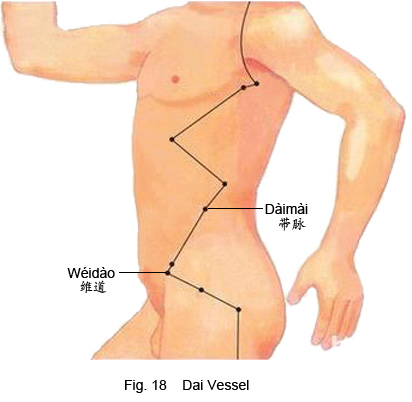
4.1 Running route
The Dai Vessel originates at the hypochondrium, runs obliquely downward to the Daimai point (GB 26), and then runs transversely around the waist and abdomen (Fig. 18).
4.2 Functional characteristics
The Dai Vessel wraps around the waist in a similar manner as a girdle. Its functional characteristics are as follows :
4.2.1 Blinding and controlling the channels running vertically
The Dai Vessel is the only vessel that runs around the waist. It runs around the waist and is able to bind all channels that run vertically.
4.2.2 Controlling the white in women
It is found by clinical observation that vaginal discharge of women has certain connection with the function of Dai vessel.
5. Yinqiao and Yangqiao Vessels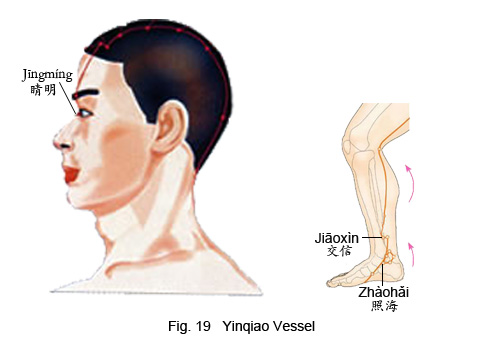
5.1 Running route
The Qiao Vessel exist as a pair on the left and right sides of the body. Both the Yinqiao and Yangqiao Vessels originate from the site inferior to the malleoli. The Yinqiao Vessel originates inferior to the medial melleolus and runs upward, via the posterior side of the medial malleolus and along the medial aspect of the chest to Quepen (ST 12). Running further upward along the area anterior to Renying (ST 9), it runs by the bright of the nose to the inner canthus and meets with the Taiyang Vessels of the hand and foot, and the Yangqiao Vessel (Fig. 19).
The Yangqiao Vessel originates inferior to the external malleolus. It runs upward via the posterior side of the external malleolus and along the posterior border 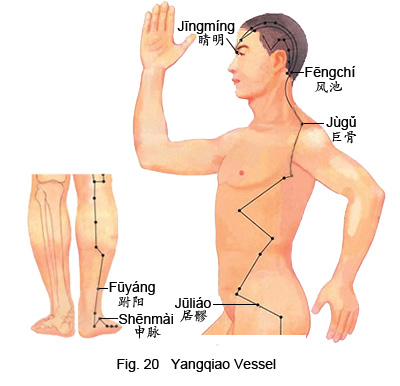 of the fibular aspect of the thigh. Passing through the abdomen and along the posterolateral aspect of the chest, it runs upwards via the shoulder and lateral side of the neck to the angle of the mouth. Reaching the inner canthus, it meets with the Taiyang Vessels of the hand and foot, and the Yinqiao Vessel. It then further ascends through the anterior hairline, turns down to the retroauricular region, and finally meets the Gallbladder Vessel of the Foot Shaoyang at the nape (Fig. 20).
of the fibular aspect of the thigh. Passing through the abdomen and along the posterolateral aspect of the chest, it runs upwards via the shoulder and lateral side of the neck to the angle of the mouth. Reaching the inner canthus, it meets with the Taiyang Vessels of the hand and foot, and the Yinqiao Vessel. It then further ascends through the anterior hairline, turns down to the retroauricular region, and finally meets the Gallbladder Vessel of the Foot Shaoyang at the nape (Fig. 20).
5.2 Functional characteristics
The Chinese word “qiao” means to act quickly. Their function are as follows:
5.2.1 Controlling the motion of the lower limbs
The Qiao Vessels originate from the sites inferior to the malleoli and run up along the medial and lateral sides of the limb to the head and face. They have the function to communicate the yin and yang qi of the whole body, and regulate the muscles in order to make the lower limbs forceful and nimble in motion.
5.2.2 Dominating the opening and closing of the eyelids
The Yinqiao and Yangqiao Vessels meet at the inner canthus and enter the brain. They therefore have the function of moistening the eyes and controlling the closing and opening of the eyelids.
6. Yinwei and Yangwei Vessels
6.1 Running route
The Yinwei Vessel originates from the medial side of the legs where the three yin vessels of the foot meet. It runs up along the medial side of the lower limbs to the abdomen, and then coincides with the Spleen Vessel of the Foot Taiyin. Arriving at the hypochondrium, it meets with the Liver Vessel of the Foot Jueyin. It then ascends to the thraot to meet with Ren Vessel (Fig. 21).
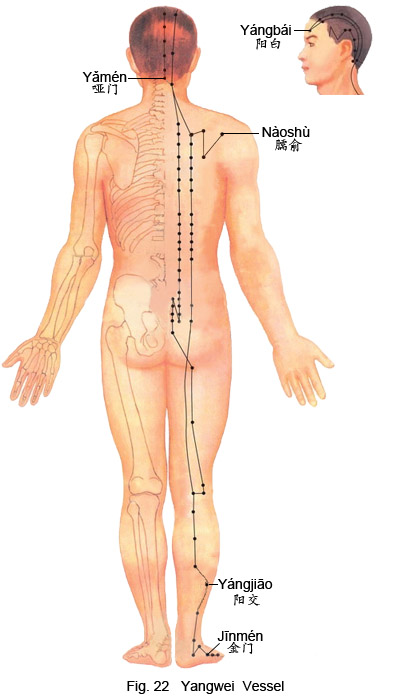 The Yangwei Vessel originates inferior to the external malleolus. Coinciding with the Gallbladder Vessel of Foot Shaoyang, it runs up along the lateral side of the lower limb to the posterolateral aspect of the trunk. Passing through the posterior axilla to the shoulder, it further ascends via neck and retroauricular region, and forward to the forehead. It then turns backward to the lateral side of the head and back of the nape, where it communicates with the Du Vessel (Fig. 22).
The Yangwei Vessel originates inferior to the external malleolus. Coinciding with the Gallbladder Vessel of Foot Shaoyang, it runs up along the lateral side of the lower limb to the posterolateral aspect of the trunk. Passing through the posterior axilla to the shoulder, it further ascends via neck and retroauricular region, and forward to the forehead. It then turns backward to the lateral side of the head and back of the nape, where it communicates with the Du Vessel (Fig. 22).
6.2 Functional of characteristics
The Chinese word “wei ‘ means maintaining and network. The Yinwei and Yangwei Vessels maintain and network the yin and yang channels of the whole body respectively.

